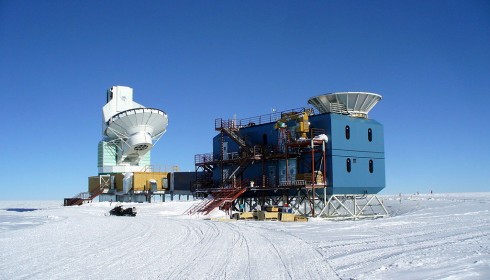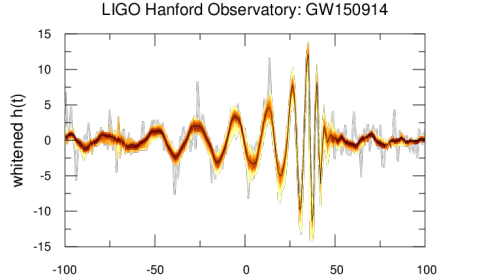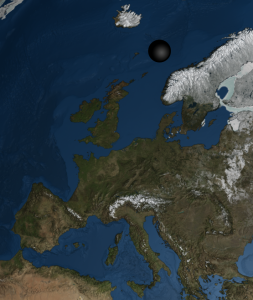tl;dr: we have detected gravitational waves! Read our paper in Physical Review Letters here!
Update: we hosted a Reddit Ask Me Anything (AMA) session over the past few days. The reception was incredible and we tried to answer as many questions as we could. Take a look at our responses!
Back in 2014 I wrote about the supposed discovery of gravitational waves from the BICEP2 project in the Antarctic. This experiment was looking for echoes in the microwave spectrum from the Big Bang in the form of primordial gravitational waves, hoping to uncover evidence of inflation: the rapid expansion of the universe that helps to explain why the universe now appears to be so uniform. This evidence was thought to have been imprinted as a distinct pattern in the polarisation of the cosmic microwave background measurable from Earth with highly sensitive instruments.

The BICEP2 Observatory in the Antarctic.
Einstein's missing jigsaw piece
As the last untested theory of Albert Einstein's 100 year old General Theory of Relativity, the discovery of gravitational waves would have been big news. Unfortunately, it turned out that the evidence for the waves and inflation the researchers thought they saw in the data was actually a calibration error. The effect of cosmic dust clouds had not been fully understood and removed from the data, and it turned out that this was a significant oversight. Later measurements from the Planck satellite ruled out BICEP2's conclusions entirely.
During the eventful few months while the academic community scrutinised the BICEP collaboration's findings, I was very hopeful that my own collaboration, another group searching for gravitational waves, would have firm proof of their existence before beginning our first advanced science run after 5 years of upgrades.
As part of the Institute for Gravitational Research at the University of Glasgow, I am a member of the LIGO Scientific Collaboration (LSC). We are collectively a group of 1000+ scientists from 80 institutions in 15 countries dedicated to the efforts to build giant gravitational wave detectors on the ground and in space and to analyse the terabytes of data they produce. I work on instrumentation, where I am investigating alternative interferometer topologies, simulating the control schemes for future detector designs and measuring new types of mirrors (more information on my academic website). My colleagues in Glasgow - one of the largest individual groups within the LSC - work on a variety of other topics, including low-noise coatings and suspensions (something of a Glasgow speciality) and data analysis techniques.
A fortunate signal

Binary black hole merger artistic impression kindly provided by Aurore Simonnet, E/PO Sonoma State University
In September 2015, our first science run was due to begin. O1 was supposed to start on September 14th, but after an "all-hands" telecon was called to determine observation readiness, it became apparent that a very minor aspect of the software - one which in no way affected the detector sensitivity or the validity of its data - was not fully implemented. As some of us had been waiting years, or even decades, for such a sensitive science run to start, it wasn't a difficult decision to postpone the start of the run for four days. As luck would have it, however, the first gravitational wave detected on Earth was in fact detected by the interferometers on the day the run was originally due to start - September 14th! Luckily the detectors in Hanford (Washington State) and Livingston (Louisiana) were exquisitely locked and fully sensitive, ready to hear the ringing of two coalescing black holes loud and clear. The logbook entry from the morning of the event read: "Operating Mode: Observing. Range: 68 Mpc. Seismic is quiet; weather is clear." In this pre-observation period only a few days before the official start of O1, the detectors were for all intents and purposes in "observing" mode, with only some calibration issues to iron out, so they were completely capable of detecting gravitational wave signals. The only confusion at that time was because we were not expecting a signal so wonderfully clear! How could such a loud and clear event be real!? See for yourself:

GW150914 at LIGO Hanford (credits: N. Cornish, MSU; J. Kanner, CIT; T. Littenberg, UAH; M. Millhouse, MSU)

GW150914 at LIGO Livingston (credits: N. Cornish, MSU; J. Kanner, CIT; T. Littenberg, UAH; M. Millhouse, MSU)
In the days and weeks following the detection the main focus was on gathering enough background data to determine the event's false alarm rate - a task designed to answer the question: "how likely is it that this event is just an unfortunate instance of noise, given the characteristics of the detectors?". To answer this question, we need a hell of a lot of data. Server farms in the USA and Europe crunched numbers constantly for days and weeks, racking up 50 million CPU hours, eventually determining the false alarm probability was low enough to merit a detection reaching the fabled 5 sigma status.
Belief
There was not an immediate realisation, at least from my experience, that we really had made the first ever direct detection of gravitational waves. After the first flurry of emails on September 15th and the masses of labbook and mailing list entries in the days following, we gradually started to rule out more and more possible false alarms and it became more and more clear that something special had been observed. The point at which a lot of collaboration members really started to believe the signal, including me, was three weeks after the event when the results from the false alarm analysis were unveiled. This process necessarily involves a "closed box" analysis where the researchers look at auxiliary data channels from the detectors in order to remove any known false alarms (no Schrödinger's cats here). The idea is that obvious, accidental or intentional noise transients are removed from the data to get a true idea of the false alarm probability of the detectors themselves when they are left alone. When commissioners stomp too heavily near the detectors or cars rumble past too quickly, this data is identified in auxiliary channels and removed from the data. This process must, to avoid human bias, be conducted blindly without reference to the putative event. In doing this, we can be confident that we have treated the noise analysis fairly and can claim the detection statistic we calculate as scientific fact.
Human nature
The procedure laid out long before the detection asked that the collaboration spokesperson - Gaby Gonzalez - appoint a paper coordination committee tasked with gathering the results from the analyses and writing the text of the scientific journal article to be submitted in due course. Once Gaby had put together an experienced team of collaboration members to coordinate the production of the paper, the task presented to all of us was to help write, read and scrutinise the draft as it was moulded from a smattering of statements and plots into a manuscript to be read by scientists for decades and perhaps centuries to come. A mailing list was set up for discussion to take place, and this proved to be extremely popular. As a PhD student I am fairly inundated with emails as a normal part of my day, but membership of the paper coordination mailing list instantly tripled my daily haul. While most of the discussion was merited, the occasional mundane issue was mercilessly wrangled to the point at which I would mark entire threads of emails as read without actually opening them. But, chaotic as this seemed, the paper coordination team managed to assemble over a dozen drafts which were each refined to a greater extent than the last until we were left with something which, in my opinion, is an exquisite single malt of a paper that will stand the test of time. I am truly grateful to the team for managing the barrage of scientific, clerical and grammatical discussion flying back and forth across the Atlantic.
Over that period, an aspect we had to contend with that I had not expected was leaks to the public. Only a few weeks after the event the news spread on social media that we had detected something. While this particular news was only speculation, it did win clout in the form of a tweet from a famous astronomer. This did not help our efforts, as increased public speculation pressured the paper team and data analysis colleagues within the collaboration to hasten the analysis and cut corners: something which none of us wanted to do. Numerous reminders were sent to the entire collaboration asking us to be careful with paper drafts left in printers, discussions with friends, family and colleagues not in the collaboration, and email recipients. I think the initial social media leaks could be blamed on accidental, over-exuberant conversation from excited scientists - something most of us are probably guilty of. Later, however, the public at large started to learn more and more information about the event that could only have been gained directly from collaboration members. Unfortunately I witnessed some individuals claiming to be members of the LSC posting on websites like Reddit with details of the event. One such poster stands out in my mind because they chose the username "LIGO_mole". How crass. Fortunately, in some part due to the discipline of the rest of the collaborators and in another part due to the noble decision taken by the professional media to avoid partaking in mere speculation, the spotlight moved away from us and we were able to continue the paper discussion and analysis unimpinged.
Finally public
As the holidays passed in 2015 and we moved into the new year, a full century after Einstein's work was published, we geared up to tell the world of our wonderful findings. Now that you are reading this article the news is public. I had very little to do with the whole process - though I would like to think I will be involved in future detector designs and discoveries - but it has been a fascinating journey and I am extremely grateful to have been a part of such a wonderful piece of history. Here's to the LIGO, Virgo, GEO, KAGRA and, hopefully one day, eLISA: the gravitational wave detectors of the present and future. Long may you listen to the cosmic symphony of space time, and let us open up this new window into the universe and gaze upon the innards of black holes, supernovae and neutron stars! Huzzah!
More information
There are a whole bunch of other blog posts from LIGO Scientific Collaboration members which you should take a look at:
- Shane Larson: on the harmonies of spacetime
- Christopher Berry: a focus on parameter estimation
- Roy Williams
- Matt Pitkin: general low-level info about gravitational waves, GW150914 and a description of what he was doing when the signal arrived
- Daniel Williams: riding the wave, from the point of view of a new collaboration member
- Amber Struver: LIGO makes the first direct detection of gravitational waves
- Brynley Pearlstone: Einstein was right!
- Andrew Williamson
- Rebecca Douglas: brief summary of gravitational waves, including a timeline and a few thoughts looking forward
Martin Hendry, our head of school in Glasgow and a fantastic proponent of public outreach, wrote an article for The Conversation which has been picked up by Time Magazine.
Please also take a look at my academic web page, some interesting Twitter accounts (@LIGO, @martin_astro, @BeckyDouglas, @GlasgowGist, me!), gwoptics.org and the official LIGO website for more information.
